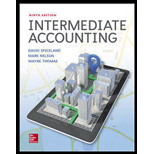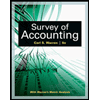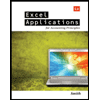
(1)
Change in the accounting principles
Change in the accounting principle means change in the accounting methods and accounting estimates. Examples are changes in methods of
Accounting error
Accounting error is that mistake which occur in accounting, relating to a routine activity or relating to the principle of accounting.
To prepare: The Journal entries in the result of the change or error correction, and
(1)
Explanation of Solution
The journal entries in the result of change or error correction, and adjusting entries for 2018 related to the situation described are as follows.
a)
| Account Titles and Explanation | Post Ref. |
Debit ($ In Millions) |
Credit ($ In Millions) |
| Inventory | 10 | ||
| |
10 | ||
| (To Record The Adjustment Entry) |
Table (1)
Inventory understated in the year 2017 was adjusted with retained earnings in the beginning of the year 2018. There is increase in the inventory after adjustment thus, inventory is debited. Retained earnings are also increased after adjustment thus, retained earnings are credited.
Note: overstatement of inventory in the year 2016 are adjusted automatically in the year 2018, thus no adjustment entry is required.
b) Journal entry for settlement of lawsuit
| Account Titles and Explanation | Post Ref. |
Debit ($ In Millions) |
Credit ($ In Millions) |
| Litigation (Liability) | 7 | ||
| Litigation (Gain) | 3 | ||
| Cash | 4 | ||
| (To record the settlement of lawsuit entry) |
Table (2)
A liability was accrued in 2016 for a probable payment of $7 million in connection with a lawsuit ultimately settled in December 2018 for $4 million. There is a decrease in the liability, thus litigation (liability) is debited. Decrease in the cash, thus cash is credited. There is a contingency gain (litigation gain) of $3 millions, thus it is credited.
c) A patent costing $18 million at the beginning of 2016, expected to benefit operations for a total of six years, has not been amortized since acquired.
| Account titles and Explanation | Post Ref. |
Debit ($ In Millions) |
Credit ($ In Millions) |
| Retained Earnings | 6 | ||
| Patents | 6 | ||
| (To record Patents Amortization adjustment entry) |
Table (3)
Patents costing $18 million in 2016, has amortized in the year 2018. The amortization value is $3 million per year. As it is not amortized in the years 2016 and 2017 then the amount $6 million (
| Account titles and Explanation | Post Ref. |
Debit ($ In Millions) |
Credit ($ In Millions) |
| Patent Amortization Expense | 3 | ||
| Patent | 3 | ||
| (To record Amortization entry for 2018) |
Table (4)
In the 2018, patent is amortized. It decreases patent account thus, patent account is credited. Patent amortization expense is debited.
d) Depreciation expenses recorded
| Account titles and Explanation | Post Ref. |
Debit ($ In Millions) |
Credit ($ In Millions) |
| Depreciation Expense (a) | 4 | ||
| |
4 | ||
| (To Record the Depreciation Expense for 2018) |
Table (5)
change in the method of depreciation is a change in the accounting estimate. So there is no need of retrospective restatements of financial information. Depreciation is an expense thus it is debited. Accumulated depreciation increased, it decreases asset value and thus it is credited.
Working note:
- (a) Compute depreciation expense after the change in the method of depreciation in 2018.
| Particulars | $ In Million |
| Cost Of The Equipment | 30 |
| Less: Depreciation In 2016 (SYD Method) | 10 |
| Depreciation In 2017 (SYD Method) | 8 |
| Undepreciated Equipment Cost (a) | 12 |
| Estimated Remaining Life Of The Equipment (b) | 3 years |
| Annual Depreciation On SLM (c) =
|
4 |
Table (6)
Note: SYD issum-of-the-years’-digits method of depreciation and SLM is straight-line method of depreciation.
Compute depreciation in SYD method for 2016 and 2017
Where n is estimated life of the asset.
(2)
Theamounts are reported again in the 2016–2018 comparative financial statements.
(2)
Explanation of Solution
Revised values in 2016 are as follows for comparative financial statements.
| Particulars | Assets | Liabilities | Share holders’ equity |
Net income |
Expenses |
| in 2016 | $740 | $330 | $410 | $210 | $150 |
| 2016 inventory | (12) | (12) | (12) | 12 | |
| contingency loss | No prior period adjustments | ||||
| patent amortization | (3) | (3) | (3) | 3 | |
| depreciation | No prior period adjustments | ||||
| revised values | $725 | $330 | $395 | $195 | $165 |
Table (7)
Revised values in 2017 are as follows for comparative financial statements.
| Particulars | Assets | Liabilities | Share holders’ equity |
Net income |
Expenses |
| In 2017 | $820 | $400 | $420 | $230 | $175 |
2016 inventory (overstated) |
12 | (12) | |||
2017 inventory (understated) |
10 | 10 | 10 | (10) | |
| Contingency loss | No prior period adjustments | ||||
| Patent amortization | (6) | (6) | (3) | 3 | |
| Depreciation | No prior period adjustments | ||||
| Revised values | $824 | $330 | $424 | $249 | $156 |
Table (8)
- In the year 2016, inventory is overstated by $12 million. It increases expenses and decreases net income. Decrease in the net income decreases shareholders equity and overvaluation of inventory decreases assets after adjustment.
- In the year 2017, inventory understated by $ 10 million. Adjust the overvaluation of inventory on 2016 first. Undervaluation of inventory in 2017 decreases expenses and increases net income. Increase in the net income increases shareholders equity and undervaluation of inventory increases assets after adjustment.
- Contingency loss occurred in 2016, settled in 2018 thus, there is no adjustment entries are needed.
- A patent costing $18 million at the beginning of 2016, expected to benefit operations for a total of six years, has not been amortized since acquired. In the year 2016, patent amortization amount $3 million is deducted from assets. It is an expense thus it is added to expenses. Increases in expenses decreases net income, decrease in net income decreases shareholders’ equity.
- In 2017, patent amortization expenses are added to expenses, it increases expenses. Increases in expenses decreases net income. Assets and shareholders’ equity are decreased by cumulative patent amortization amount of 2016 and 2017.
- There are no prior period adjustments for depreciation in 2016 and 2017. Change in the depreciation method reported prospectively from the first financial statements after such change.
Want to see more full solutions like this?
Chapter 20 Solutions
INTERMEDIATE ACCOUNTING (LL) W/CONNECT
- I need help with this general accounting question using the proper accounting approach.arrow_forwardPlease help me solve this general accounting problem with the correct financial process.arrow_forwardI need assistance with this financial accounting question using appropriate principles.arrow_forward
- Please explain the solution to this financial accounting problem with accurate principles.arrow_forwardI am trying to find the accurate solution to this general accounting problem with appropriate explanations.arrow_forwardCan you explain the correct methodology to solve this general accounting problem?arrow_forward
 Survey of Accounting (Accounting I)AccountingISBN:9781305961883Author:Carl WarrenPublisher:Cengage Learning
Survey of Accounting (Accounting I)AccountingISBN:9781305961883Author:Carl WarrenPublisher:Cengage Learning Excel Applications for Accounting PrinciplesAccountingISBN:9781111581565Author:Gaylord N. SmithPublisher:Cengage Learning
Excel Applications for Accounting PrinciplesAccountingISBN:9781111581565Author:Gaylord N. SmithPublisher:Cengage Learning Cornerstones of Financial AccountingAccountingISBN:9781337690881Author:Jay Rich, Jeff JonesPublisher:Cengage Learning
Cornerstones of Financial AccountingAccountingISBN:9781337690881Author:Jay Rich, Jeff JonesPublisher:Cengage Learning



